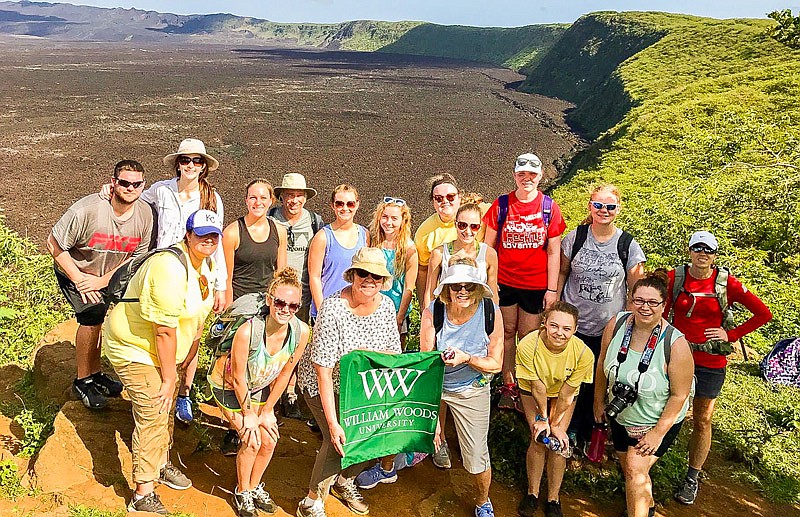Students and teachers from William Woods University returned from quite an excursion last week.
Several students traveled to the Galpagos Islands as part of "Woods Around the World," a yearly program that allows William Woods students to travel globally.
One of the students on the trip, Megan Brown said the chances of a return visit to the Galpagos are becoming remote.
"They are getting restrictive on the number of tourists that visit," she said. "It really makes the trip once in a lifetime."
"Their ability to preserve the island depends on tourist dollars," said Travis Tamerius, WWU's director for Center of Ethics. "At the same time, they are trying to minimize the tourists' ecological foot print."
Student Ava Demanes said she could not pass up the opportunity to satisfy some of her academic curiosity.
"The bio-diversity there is crazy," she said. "There are so many endemic species, and it's just a place you may never have a chance to go to again."
Baylie Borman said she was excited to interact with the animals on the island.
"I was interested in seeing the giant tortoises and swimming with sea turtles," she said. " I went snorkeling three times and got to swim with 3-foot-long sea turtles."
Many students had never traveled outside of the country, Tamerius said, and for two, it was their first time on an airplane.
"This was my first time through international customs," Brown said. "It was a cool experience. When we were on the flight, we flew over the ocean for what seemed like forever."
Tamerius said the methods of travel while on the islands made for a busy schedule.
"One day, we had 10 transfers," he said.
"Each island required a speed boat to get to," Demanes added. "In one day, we took a bus to the airport, then an airplane, then a bus to another plane. Then we flew on the second plane, had a layover and then, finally, we arrived. Once there, we had to ride on a ferry, then another bus, then a bus to a water taxi and then finally a speed boat."
When it came to luggage, some students were luckier than others.
"On the first day, I lost one wheel on my luggage," Shannon Graziano said. "On the second day, I lost the other."
Tamerius said it took everyone a lot of work to haul belongings from island to island, and the trip took its toll.
"When we got on the boats, the first thing they hand you is a barf bag," he said. "Two students did get sick."
Once on the island, the group got down to doing as much as possible.
"We did and saw everything," Brown said. "We saw every animal, every tree. Everything."
According to Borman, the local wildlife was friendly.
"The sea lions were very chill," she said. "They just acted like they were used to humans. They even got on top of our bags at one point."
Demanes also found the sea lions to be very personable.
"They were very human-like," she said. "Before we left the dock, I saw one in the water, and pointed it out. The person next to me said, 'There is one right next to us.' It was like 10 feet away."
A very special sight for the visiting students was a look at the world's rarest animal, "Lonesome George," a Pinta Island tortoise.
"He was the last individual in his subspecies," Tamerius said. "Unfortunately, he could not mate. So when he died in 2012, they had him taxidermied. After being displayed in New York, he came back and is exhibited in Galpagos."
Another unforgettable adventure for Tamerius was hiking to the top of Sierra Negra.
"It's a very active volcano," he said. "It also has the second largest crater. Our guide took us to the top, and it's not something they normally do. We only had so much time in the park, so we actually ran up to the top. The views were incredible."
Demanes said the long hike was worth it.
"It was about 10-11 miles total," she said. "When were getting up to the top, we ran. Uphill. When we got to the top, it was just dead silent."
"We had the whole place to ourselves," Tamerius said.
"It was breath taking," Demanes said. "When I get stressed out, I just close my eyes; I think of that mountain top. I could think about it forever."
Brown said the most surprising thing about the trip was getting to experience the local culture.
"I had never been out of the country before," she said. "I thought it would be commercialized, just like here. But it wasn't; it was very people-oriented. There was one main street and that was the whole island."
Brown said gazing at the night sky was her favorite part of the trip.
"On Isabella Island, I slept on the roof," she said. "A friend and I stargazed, and saw shooting stars. The next morning, we woke up for the sunrise. To one side was the sunrise, another was the ocean and another was the mountains. Finally, you could see the main street. It was a gorgeous, random moment and the best thing I could have done."
Graziano said the smells and the people were his favorite part.
"As soon as I got off the plane, I could smell the ocean," he said. "One of our guides was Franklin, a naturalist. Now that's a man who loves his job. He had endless knowledge and enthusiasm for his home. When were were leaving, he said, 'Hasta la bye bye.'"

